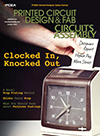Products
LPKF MicroLine 350Ci laser system provides stress-free depaneling of assembled PCBs.
Features higher cutting speeds for mechanical depaneling methods; requires no expensive tooling.
The laser technique leaves no residual dust on the PCBs and will not damage sensitive components. Cuts any contours while maintaining higher precision than mechanical routing systems. The non-contact and stress-free cutting process, with a very small beam diameter, allows components to be placed close to the edge of the board for optimum utilization of the panel.
Can be integrated in an existing SMD production line, or used as a stand-alone work station.
LPKF Laser & Electronics, lpkf.de
Features higher cutting speeds for mechanical depaneling methods; requires no expensive tooling.
The laser technique leaves no residual dust on the PCBs and will not damage sensitive components. Cuts any contours while maintaining higher precision than mechanical routing systems. The non-contact and stress-free cutting process, with a very small beam diameter, allows components to be placed close to the edge of the board for optimum utilization of the panel.
Can be integrated in an existing SMD production line, or used as a stand-alone work station.
LPKF Laser & Electronics, lpkf.de
The ProtoFlow oven, with Pb-free capability, reportedly has significant advantages over previous models. Has new PC control software package. Four user-positioned temperature sensors and a microprocessor controller regulate an even heat distribution over PCBs up to 9 x 12” (228 x 305 mm).
Several user programmable zones between preheating and final re-flow process reflow profiles up to 320°C.
The temperature profile measured by the four freely positioned sensors is displayed in real time on the PC. The reflow process can also be observed through a large glass window.
Ideal for prototyping, technology research and pre-production runs, it is a high tech, user friendly, reflow oven with many pre-programmed process profiles that can be selected via the LCD display and keypad. Intuitive software package enables process parameters to be changed, managed and archived on a PC.
LPKF Laser & Electronic, lpkf.com
Several user programmable zones between preheating and final re-flow process reflow profiles up to 320°C.
The temperature profile measured by the four freely positioned sensors is displayed in real time on the PC. The reflow process can also be observed through a large glass window.
Ideal for prototyping, technology research and pre-production runs, it is a high tech, user friendly, reflow oven with many pre-programmed process profiles that can be selected via the LCD display and keypad. Intuitive software package enables process parameters to be changed, managed and archived on a PC.
LPKF Laser & Electronic, lpkf.com
AMS 2.0 Advanced Manufacturing Suite recognizes that fast, error-free NPI, minimization of changeovers and labor costs, and logistical efficiency demand that the component placement function is integrated into the overall production environment. Focuses on maximizing the performance of Assembléon machines and providing connectivity to other machines and software in the factory.
Moves many production preparation functions off-line, assures error-free set-ups and eliminates bottlenecks and component starvation.
Rapid NPI is achieved by decoupling preparation tasks from board production through off-line implementation of operations such as creation of vision files and data preparation, electrical verification of R, C and L values, and checking of the barcodes on reels. Provides a central database for programs and vision files.
Has production scheduling and line optimization functionality. Generates placement programs and feeder set-ups for every machine in the production line. A feeder viewer enables analysis and allows dynamic re-assignment of feeders.
Has off-line and on-line verification of set-ups, with an optional CLi interface using RFID technology for automatic set-up verification. Provides line control and data transfer with all machines in the line, with functionality including production line start/stop, upload/download of programs and component database information to the line, MIS data download and line warm-up. Can enable remote line monitoring and operation.
Data from set-up verification supports logistics by monitoring component usage and tracking inventory, issuing an alert on potential shortages to avert component starvation. Timely information to the operator indicates how many boards can still be produced or how many production hours remain with the available on-machine component inventory. The component tracking software also forms the foundation for the lot traceability system, which tracks complete production details on a real-time basis for possible future product recalls.
User interface matches the Assembléon machine user interface.
Assembléon, assembleon.com
Moves many production preparation functions off-line, assures error-free set-ups and eliminates bottlenecks and component starvation.
Rapid NPI is achieved by decoupling preparation tasks from board production through off-line implementation of operations such as creation of vision files and data preparation, electrical verification of R, C and L values, and checking of the barcodes on reels. Provides a central database for programs and vision files.
Has production scheduling and line optimization functionality. Generates placement programs and feeder set-ups for every machine in the production line. A feeder viewer enables analysis and allows dynamic re-assignment of feeders.
Has off-line and on-line verification of set-ups, with an optional CLi interface using RFID technology for automatic set-up verification. Provides line control and data transfer with all machines in the line, with functionality including production line start/stop, upload/download of programs and component database information to the line, MIS data download and line warm-up. Can enable remote line monitoring and operation.
Data from set-up verification supports logistics by monitoring component usage and tracking inventory, issuing an alert on potential shortages to avert component starvation. Timely information to the operator indicates how many boards can still be produced or how many production hours remain with the available on-machine component inventory. The component tracking software also forms the foundation for the lot traceability system, which tracks complete production details on a real-time basis for possible future product recalls.
User interface matches the Assembléon machine user interface.
Assembléon, assembleon.com


